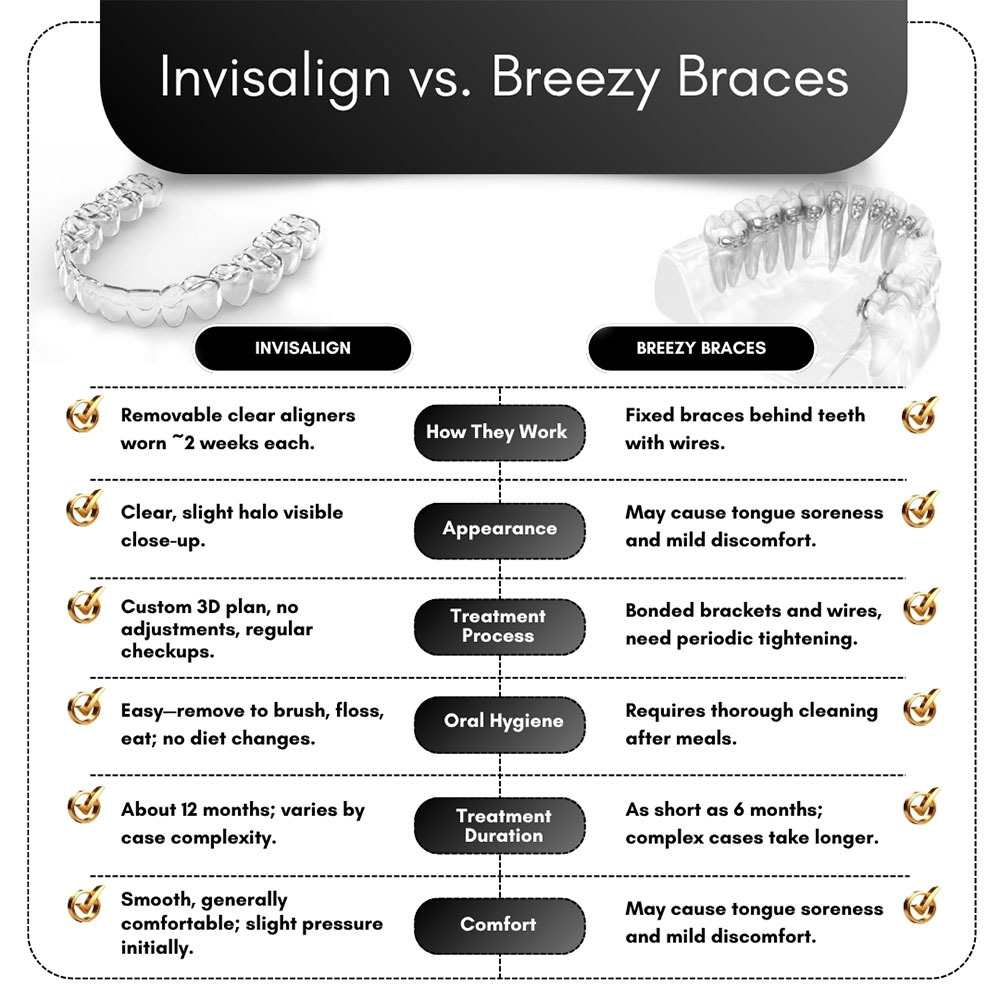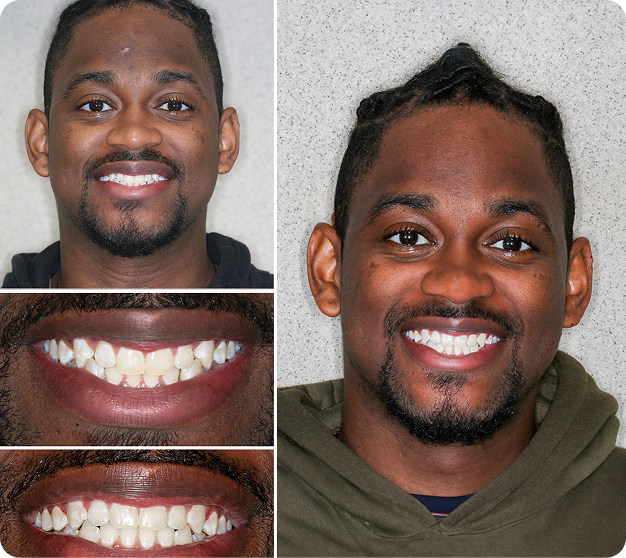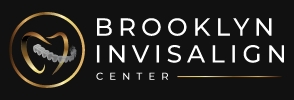Explore more Invisalign comparisons and alternatives. Learn how Invisalign measures up against other orthodontic treatments and discover which option might be best for your smile.
What Is Invisalign?
Instead of using fixed brackets and wires to straighten teeth, they are realigned using a series of clear plastic aligners. These are made to fit exactly over your teeth, exerting a specific amount of pressure on each tooth, so it gradually moves into the proper position. The aligners are removable, and each set is worn for approximately two weeks.
Invisalign effectively treats different types of uneven bite, making it a flexible orthodontic solution. It can also help people with TMJ & overjet.
- Invisalign for Overbite
- Invisalign for Crossbite
- Invisalign for Crowded Teeth
- Invisalign for Underbite
- Invisalign for Gap Teeth
- Invisalign for Open Bite

What Are Breezy Braces?
These are fixed braces, but instead of fitting onto the outer surfaces of your teeth, they are fitted on the inner surfaces nearest your tongue. They are also called lingual braces. The braces consist of tiny brackets that are cemented onto the inner surfaces of your teeth and attached to a thin wire that powers them. They work continuously to straighten your teeth.
In this article, we look at the differences between these removable clear aligners and fixed lingual braces. A comparison of how each works and what to expect during treatment will help you understand whether you’re an Invisalign candidate or may need lingual braces.

Appearance
Invisalign
- The clear plastic aligners in this treatment are discreet and fit tightly over your teeth.
- The aligners are not entirely invisible as you may be able to see a slight halo around each tooth if you look very closely.
Breezy Braces
- Breezy braces are invisible because they fit on the inner surfaces of your teeth.
Comfort
Invisalign
- Invisalign aligners are known to be comfortable since they are made from smooth, clear plastic.
- There are no sharp or hard edges that can stick into sensitive gums, cheeks, or lips.
- Invisalign aligners can initially feel uncomfortable when you first wear a new set.
Breezy Braces
- Lingual braces are reasonably comfortable, but your tongue could feel sore as it is tempting to play with the brackets and wires.
- Breezy Braces can cause minor discomfort, just like all orthodontic systems, since your teeth are forced to move.
Treatment Process
Invisalign
- Invisalign aligners are made using 3-D CADCAM technology that creates a custom digital treatment plan.
- During your treatment, you wear each aligner set for about two weeks before moving on to the next set in the series.
- The aligners are custom-made to move your teeth in tiny increments and, therefore, don’t require any adjustments while you use them.
- You will need to see our Invisalign provider during your treatment for regular checkups. This is just to monitor your progress, as there are no brackets or wires to adjust. However, we may make adjustments to your treatment plan if needed.
Breezy Braces
- At Brooklyn Invisalign Center, our dentist takes a 3-D digital scan of your teeth, creating a custom treatment plan.
- Breezy braces have brackets that are custom-made to fit onto your teeth. These are bonded onto your teeth at the beginning of treatment and remain in place until your teeth are straightened.
- A thin custom-made wire powers the brackets.
- Regular dental checkups are needed so any adjustments can be made to your braces, and they are tightened as needed. Because adjustments might be necessary, these checkups will take longer than those with Invisalign.
Oral Hygiene
Invisalign
- Oral care with Invisalign is very simple: you remove the aligners for brushing and flossing first thing in the morning, last thing at night, and after meals.
- You remove your aligners whenever you wish to eat and drink anything apart from water, so there is no need to make any dietary modifications.
Breezy Braces
- Breezy braces need additional oral care during your treatment. You will need to clean your mouth after each meal, in addition to first thing in the morning and last thing at night.
- You will need to spend more time cleaning around the brackets and wires thoroughly. This can be tricky and time-consuming as the brackets and wires are on the inner surfaces of your teeth.
Treatment Duration
Invisalign
- Most people spend around a year on treatment, but this can vary.
- You may complete treatment in just a few months if you only require cosmetically oriented tooth movements. More complex issues will take longer, sometimes 18 months to 2 years to complete.
Breezy Braces
- Depending on the issues requiring correction, treatment can be completed within as little as six months.
- More complex orthodontic problems will take longer to treat.
Effectiveness
Invisalign
- Invisalign is a very effective treatment that is tried and tested. Good Invisalign candidates are patients with mild-to-moderate cases but Invisalign can also help people with more complex issues.
- If you have severe bite problems, Invisalign may not be the answer.
Breezy Braces
- Breezy Braces can treat mild to moderate orthodontic problems, including spacing, overcrowding issues, and teeth rotated out of place.
- Treatment may be less suitable for complex problems.
What Our Patients Are Saying
Daily Maintenance and Follow-Up
Invisalign
- Invisalign aligners must be worn for 22 hours each day and at least 20 hours. Ideally, you should only take them out for oral hygiene and mealtimes, although they can be left out for the occasional special event.
- You will need to come and see us for regular checkups with our Invisalign provider. These checks are quick and are simply to monitor your progress.
Breezy Braces
- In addition to brushing and flossing your teeth twice daily, you must clean your teeth after every meal.
- Special tools are needed to clean around the brackets and wires, especially as you cannot see them easily. You may need a dental mirror and other tools or get a WaterPik.
- Regular checkups are needed every 6 to 8 weeks so your braces can be adjusted.
- If the wire breaks or you loosen or break a bracket, you must see an emergency orthodontist urgently. Delaying could negatively impact your treatment.
Cost
Invisalign
- Invisalign costs are similar to clear braces but are more expensive than traditional metal braces. Your price will depend on the number of aligners you need. If you need relatively few aligners, the price will be far cheaper.
- Dental insurance may cover part of the costs provided the results can be proven to benefit your oral health. Dental insurance doesn’t normally cover cosmetically oriented treatments.
Breezy Braces
- Breezy Braces are more affordable as this is a newer system on the market. However, it hasn’t been the subject of so much research and development as Invisalign.
- If your braces can improve oral health, then at least part of the treatment may be covered.
Suitability for Different Age Groups
Invisalign
- Invisalign was originally developed for adults but is also popular amongst older teens.
- Invisalign Teen is specifically for teenagers and includes modifications to accommodate teeth that haven’t yet erupted as well as compliance indicators.
- Another Invisalign system can be helpful for younger children during phase 1 treatment when they are aged between six and 10. If a child has narrow jaws, an orthodontist may recommend an Invisalign palate expander to create more space before starting aligner therapy.
Breezy Braces
- Breezy Braces is an adult-oriented braces system. Because the braces are fitted on the inner surfaces of teeth, they may be harder for younger children to look after and, therefore, less suitable.
Lifestyle Impact
Invisalign
- The removable aligners are easy to use and fit in with busy lifestyles.
- You can take out your aligners for meals, oral care, and the occasional special event. The aligners are also removable for sports.
“ I’m currently in the process of fixing my teeth with Invisalign. All of the staff are friendly and kind. The office is clean and inviting. I would highly recommend! “

Tiana Jacobs Invisalign Patient
Breezy Braces
- These braces are virtually invisible but can be tricky to look after.
- Some people find they have a lisp after their braces are fitted, and their tongue becomes sore.
- You must avoid certain foods that are hard, crunchy, or sticky and can easily become stuck around the brackets and difficult to remove. These foods may also damage the brackets and wires.
Breezy Braces is a relative newcomer to adult orthodontics and is only available in the New York area. In comparison, Invisalign is known worldwide and is an established world leader in aligner technology.
While both may provide good results, Invisalign removable aligners can be easier to care for. Oral care routines are quicker, and there is no need to avoid crunchy or hard foods that could damage Breezy Braces.
Invisalign provides predictable results and may be more effective at treating complex problems. When you see our orthodontist, we can evaluate your bite and provide an expert opinion on which system will suit you best.
Invisalign provides predictable results and may be more effective at treating complex problems, while breezy braces are used for mild to moderate orthodontic problems, like overcrowding and spacing, issues.
If you still have questions and want to choose the most effective option, Dr. Jacqueline Simons, a highly trained orthodontist, is here to help. Сall our best-in-class Invisalign dentist to book an appointment and expert guidance and personalized care.

